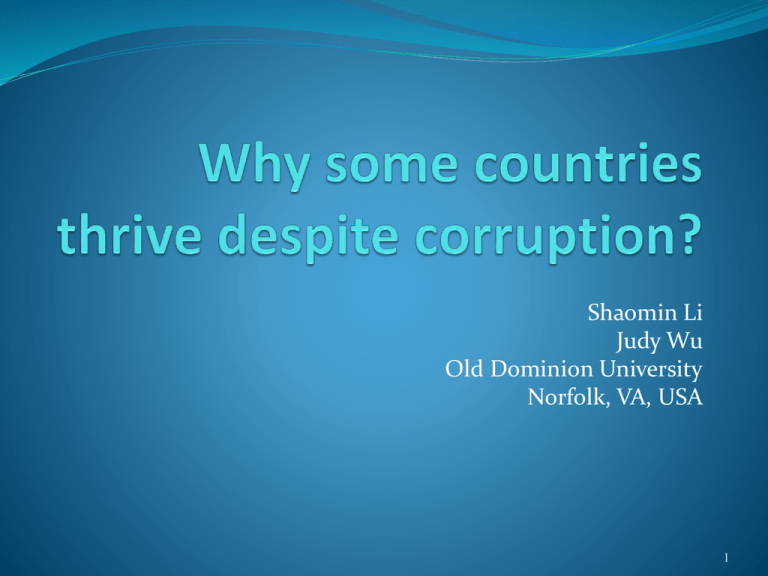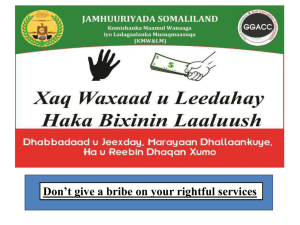2, China's Political System
advertisement

Shaomin Li Judy Wu Old Dominion University Norfolk, VA, USA 1 Corruption and economic development Dominant economic theory: corruption is bad for economic development (see review article by Svensson, 2003). 2 Corruption and economic growth The empirical evidence on the corruptionefficiency relationship is mixed. 3 The puzzle of corruption and economic growth The “East Asian paradox” (Rock & Bonnett, 2003) Past attempts to solve the puzzle The “efficiency enhancing” corruption argument (Leff, 1964; Lui, 1985, Wedeman, 2002). 4 Studies on the causes and effects of corruption Judge, et al (2008) reviewed 42 empirical studies and found: Measurements of corruption vary widely. The most used measure is the CPI developed by Transparency International. More studies focus on the causes of corruption than those on the effects of corruption. Economic explanatory variables are used the most, political variables the second, the cultural variables the third. 5 Trust--the missing link in explaining the corruption-efficiency relationship Trust: “willingness to rely on an exchange partner in whom one has confidence” (Moorman et al. 1993). Particularized vs. generalized trust The role of trust in corruption The separation of time and space in corrupted transactions requires some trust between the briber and the corrupt official. The outcome of corruption with/without trust Predatory vs. efficiency enhancing corruptions How can a society develop a high level of trust Good political and economic institutions Expansive social network 6 Our main arguments H1: corruption has a negative effect on economic growth H2: trust has a positive effect on economic growth H3: the effect of corruption on economic growth is moderated by trust. There is a interaction effect between corruption and trust on economic growth. In countries with a higher level of trust, the negative effect of corruption will be mitigated. 7 Empirical evidence Case study Statistical test 8 Corruption, trust, economic growth: China vs. the Philippines Country GDP annual growth rate (%) (19902000) GNI per capita (2001) Corruption perception index (10=best, 1=worst) Trust (1999(2000) 2004) Philippines 3.3 1050 2.8 8.6 China 10.3 890 3.1 54.5 9 Corruption in China The existence of wide and thick informal social networks in the society A high level of trust From particularized to generalized trust (evidence from Tang, 2005) How bribery-corruption relationship is formed The case of Motorola’s “slush fund” in China “The terms of the deal was…a ten million-dollar discretionary fund. Hands off, no questions asked. Don’t ask where the money goes,…We know exactly what he was up to, and exactly how successful he would be…” (Gutmann, 2004, p124). 10 How bribe is paid… “I [the briber] invite my client [corrupt official] to a well-known Cantonese restaurant with several branches in Beijing. The meal costs an astronomical 20000 rmb [$2,400] for two. On the way out, the restaurant passes a gift to my client and the client is told he or she can exchange the gift for cash if he or she does not like it. The gift is then exchanged by my client for about 10000 rmb. I have not discussed any such exchanges with my client. But just in case people get the wrong impression, the restaurant has covered my car's license plate in the restaurant's parking lot.” 11 Types of bribery-corruption transactions According to Takungpao (2006): Bribery-corruption transaction has become sophisticated: Globalization Future options 12 Corruption in the Philippines The state head controls the entry of an industry or monopolizes it Impose a tax or surcharge on all Appoint his/her cronies to be in charge of the industry Steal the taxes/surcharges. 13 Evidence from the three most important industries… The coconut industry (1970s) President Marcos imposed a tax Appointed his friend, Manuel Conjuangco, to collect it. Used the tax to subsidize mills owned by the two. The cigarette industry (1970s) Imposed 100% import duty on filters. 90% duty reduction to a company owned by Marcos’ friend, Herminio Disini. Disini in turn supplied the filter to Tan, another Marcos friend. The sugar industry (1970s) Marcos order all sugar exports be monopolized by PEC, controlled by his friend Robert Benidicto. 14 Statistical test Economic growth = a + b1(corruption) + b2(trust) + b3(corruption*trust) + B(control variables) + e Data A pooled data set 53 countries in two time periods. 76 observations in total 15 Dependent Variable: annual economic growth rate Main independent variables: Corruption. CPI 1996 and 2002 (Transparency International). Trust. World Value Survey (Inglehart, 1994-2005). 2 waves: 1994-1999 and 1999-2004. Control variables: GNI per capita (World Bank, 1994-1999 and 2000-2005). Schooling (Barro and Lee, 1995 and 2000) Political system (Freedom House, 1996 and 2002) Time, 1994-1999 and 2000-2005. 16 correlation coefficients Mean S.D. GDPpgr CORRUPT TRUST GNIp SCHOOL GDPpgr 2.94 2.56 CORRUPT 4.70a 2.53 -.220 (.056) TRUST 28.86 15.53 .290* (.011) -.588** (.000) GNIp 12.91 12.65 .132 (.257) -.872** (.000) .599** (.000) SCHOOL 8.04 2.29 .179 (.123) -.625** (.000) .417** (.000) .627** (.000) STATUS .07 0.25 -.016 (.893) .241* (.036) .146 (.208) -.254* (.027) -.304* (.008) TIME .61 .49 .219 (.057) .010 (.928) -.004 (.976) .042 (.722) -.067 (.568) STATUS .016 (.363) 17 Regression result Dependent variable: log(GDPpgr) Independent variables Model 1a Model 2a Model 3a Model 1b Model 2b Model 3b CORRUPT -.010 (.008) -.001 (.009) -.043*** (.014) -.025* (.013) -.020 (.012) -.059*** (.016) .003** (.001) .010*** (.002) .003** (.001) .011*** (.002) TRUST .001*** (.000) CORRUPT*T RUST GNIp .001*** (.000) -.004 (.003) -.005** (.003) -.005** (.002) SCHOOL .004 (.009) .001 (.009) .002 (.008) .007 (.009) .004 (.009) .004 (.008) STATUS -.025 (.065) -.080 (.069) -.130** (.065) -.031 (.065) -.103 (.068) -.150** (.064) TIME .057* (.031) .059* (.031) .055* (.028) .063** (.031) .068** (.030) .063** (.028) Intercept 2.865*** (.064) 2.863*** (.062) 2.650*** (.081) 2.811*** (.073) 2.786*** (.071) 2.582*** (.085) N 76 76 76 76 76 76 .103 .153 .293 .129 .203 .337 2.040* 2.533** 4.776*** 2.071* 2.936** 4.936*** R Square F-statistics 18 Regression result (cont’d) Log (GDPpgr) = 2.582 + (-.059+.001TRUST)*CORRUPT+.011*TRUST.005*GNIp+.004*SCHOOL-.150*STATUS+.063*TIME +error, If trust => 0, then effect of corruption on growth is 0.17%. Every 10% increase in trust => reduce the negative effect of corruption by 0.03%. H3 is supported. 19 Concluding remarks The negative effect of corruption on economic growth can be mitigated by a high level of trust in a country. The boundary between particularized and generalized trust Consequences of efficiency enhancing corruption It enriches the corrupt officials pockets; Gives them incentives to increase state power. It improves the bribing firm’s profitability. It impoverishes the state coffers. => the government has strong monopolistic power, a weakened treasure, and an efficient and wealthy business class. 20 Implications Policy implications for eradicating corruption The difficulty of cleaning corruption in societies with high level trust. Firms have little incentives to report corruption (“corruption with theft” by Shleifer and Vishiny). Strong and thick social network makes “whistle blowing” difficult). The “futures option” type of corruption. 21 Implications (cont’d) What can be done? Firms? Governments? International organizations? Further research? 22 23




